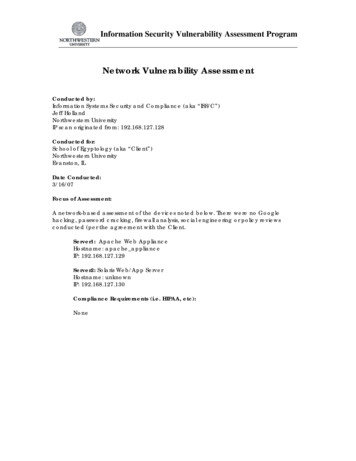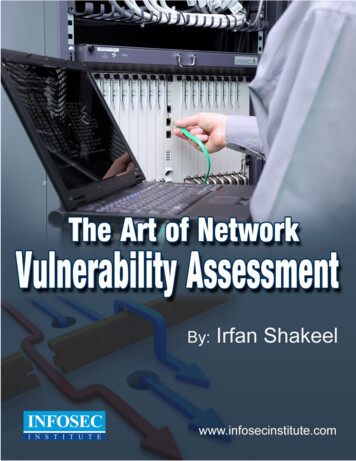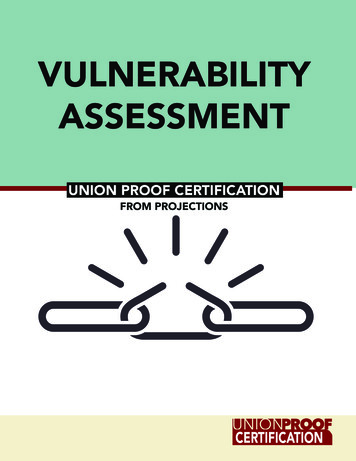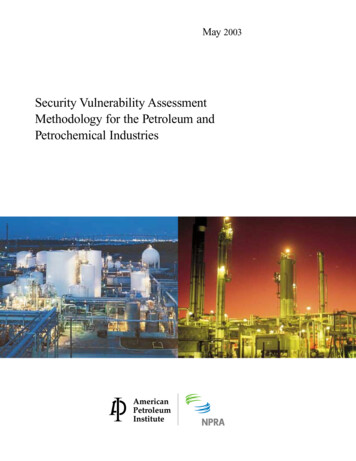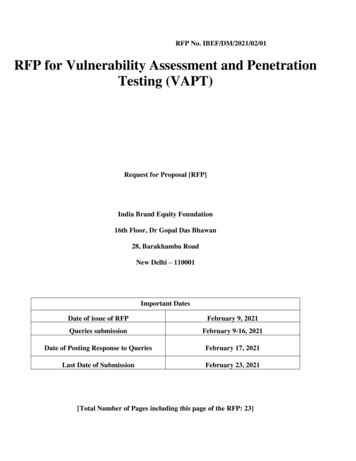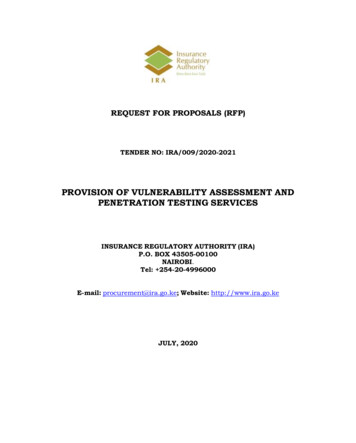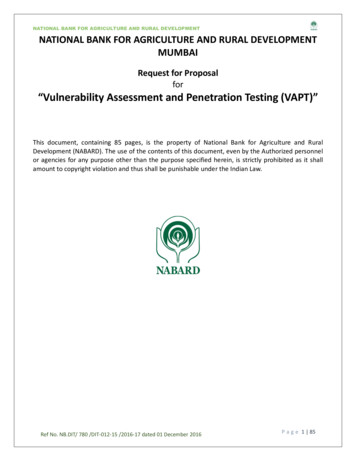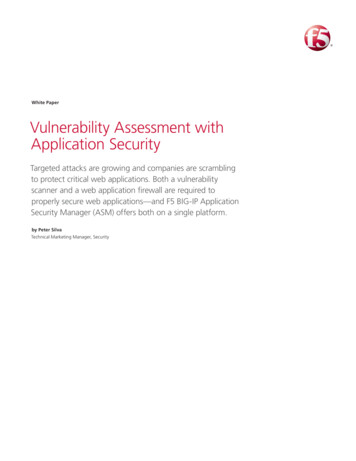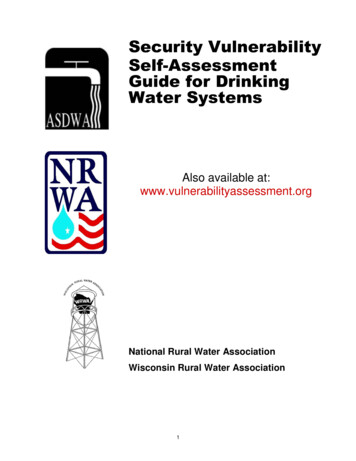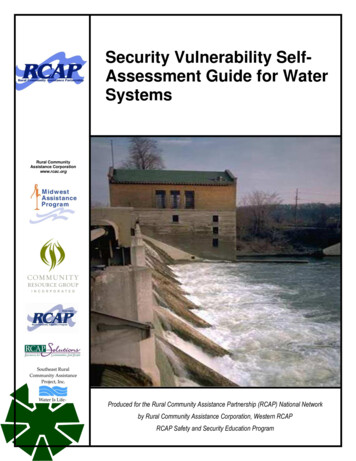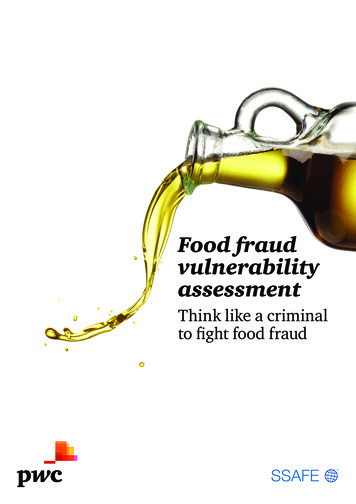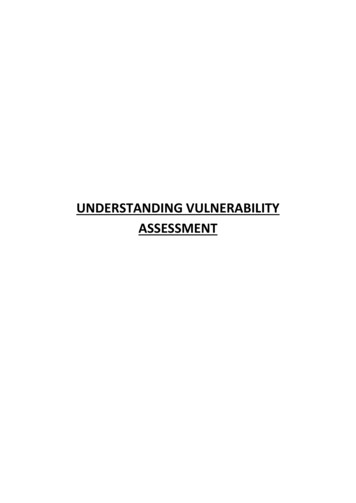
Transcription
UNDERSTANDING VULNERABILITYASSESSMENT
LiabilityThe BRC publishes information and expresses opinions in good faith, but accepts no liability forany error or omission in any such information or opinion, including any information or opinioncontained in this publication.Whilst the BRC has endeavoured to ensure that the information in this publication is accurate,it shall not be liable for any damages (including without limitation damages for pure economicloss or loss of business or loss of profits or depletion of goodwill or otherwise in each case,whether direct, indirect or consequential) or any claims for consequential compensationwhatsoever (howsoever caused) arising in contract, tort (including negligence or breach ofstatutory duty), misrepresentation, restitution or otherwise, in connection with thispublication or any information contained in it, or from any action or decision taken as a resultof reading this publication or any such information.All warranties, conditions and other terms implied by statute or common law are, to the fullestextent permitted by law, excluded.Nothing excludes or limits the liability of the BRC for death or personal injury caused by itsnegligence, for fraud or fraudulent misrepresentation or for any matter which it would beillegal for it to exclude or attempt to exclude liability for.The Global Standard for Food Safety and the terms of the disclaimer set out above shall beconstrued in accordance with English law and shall be subject to the non-exclusive jurisdictionof the English Courts.
Copyright British Retail Consortium 2015All rights reserved. No part of this publication may be transmitted or reproduced in any form(including photocopying or storage in any medium by electronic means) without the writtenpermission of the copyright owner. Application for permission should be addressed to theCommercial Director of Global Standards at the British Retail Consortium (contact detailsbelow).Full acknowledgement of the author and source must be given.The contents of this publication cannot be reproduced for the purposes of training or anyother commercial activity. No part of this publication may be translated without the writtenpermission of the copyright owner.Warning: Any unauthorised act in relation to a copyright work may result in both a civil claimfor damages and criminal prosecution.For more information about BRC, contact: British Retail ConsortiumSecond Floor21 Dartmouth Street LondonSW1H 9BPTel: 44 (0) 20 7854 8900Fax: 44 (0) 20 7854 8901Email: enquiries@brcglobalstandards.com Website: www.brcglobalstandards.com
Section 1 IntroductionThe Global Standard for Food Safety Issue 7 defines food fraud as the fraudulent andintentional substitution, dilution or addition to a product or raw material, or misrepresentationof the product or material, for the purpose of financial gain, by either increasing the apparentvalue of the product or by reducing the cost of its production. Examples include: replacing or substituting ingredients with cheaper alternatives (e.g. undeclared substitutionof extra-virgin olive oil with lower grades of olive oil or oils of other botanical origin) undeclared dilution of genuine ingredients (e.g. the dilution of fruit juices and fruit preserveswith undeclared cheaper fruits or sugar syrup) deliberate mis-labelling (e.g. of the animal species in a meat product) making false claims regarding provenance or origin (e.g. claiming organic status or making afalse geographic or varietal claim) counterfeiting to copy a well-known brand (e.g. by falsification of records and/or packaging ofinferior products, such as cheap wine).In January 2013 the Food Safety Authority of Ireland reported that horse DNA had been foundin products labelled as containing beef. This announcement resulted in an extensive incidentthroughout Europe and the recall of several beef products. However, food fraud and thedeliberate adulteration of products and ingredients are not new issues and have been inexistence for a long time. Food fraud is a global problem and due to the length and complexityof food supply chainsit often requires international solutions. Recently, there have been numerous well-publicisedincidents including those listed in Table 1.Table 1 Examples of food fraud incidentsThe scale of food fraud is not precisely known, but estimates suggest that it costs the worldeconomy 49 billion annually and is growing. In the US the University of Minnesota NationalCenter for Food Protection and Defense (NCFPD) has estimated that about 10% of US foodcould be adulterated. This matches a similar estimate by the UK Food Standards Agency, whichin 2006 also estimated that as much as 10% of consumers’ weekly shopping may becounterfeit.According to the Draft Report on the Food Crisis, Fraud in the Food Chain and the ControlThereof (2013/2091 (INI)) (European Parliament, 2013), the top 10 food products most at riskof adulteration or substitution are as follows: olive oil
fish organic products milk grains honey and maple syrup coffee and tea spices (such as saffron and chilli powder) wine certain fruit juicesThese incidents (and particularly those concerning horsemeat) have focused the attention ofthe food industry, regulatory authorities and consumers on the potential for food fraud andthe need for effective systems to prevent it. Therefore, the Global Standard for Food SafetyIssue 7 has introduced new requirements for a vulnerability assessment designed to ensurethat all sites: have assessed their raw materials and supply chains for their vulnerability to food fraudactivities have appropriate, risk-based controls in place to minimise the risk of purchasing fraudulent oradulterated raw materials.This guideline is intended to help sites understand the requirements of the Global Standard forFood Safety Issue 7 relating to food fraud and explains how to conduct a vulnerabilityassessment to meet these requirements.In addition, the BRC will develop training in food fraud awareness, details of which will bemade available on its training website, www.brctrainingacademy.comThe Global Food Safety Initiative (GFSI) has confirmed that in future all GFSI standards willneed to incorporate food fraud mitigation activities, such as the vulnerability assessment,within their requirements.
Section 2 Requirements of the standardThere are a number of requirements in the Global Standard for Food Safety Issue 7 in whichthe company must consider potential food fraud and adulteration of raw materials. These areset out in Table 2.Table 2 Summary of the requirements of the Standard concerning food fraud andadulterationofrawmaterials
Section 3 Conducting a vulnerability assessment3.1 Gathering informationThe first stage of a vulnerability assessment is to source reliable information regarding thepotential adulteration, substitution or mis-labelling of raw materials and the supply chain, onwhich the assessment can be based. This could include information as shown in Figure 1.Figure 1 Gathering information on which to base the assessmentA number of organisations have websites which provide useful background information,summaries of historical cases and news of emerging concerns. These include: US Pharmacopeial Convention (USP): https://www.foodfraud.org/ US National Center for Food Protection and Defense (NCFPD): https://www.ncfpd.umn.edu/ US Michigan State University: http://foodfraud.msu.edu/ US Food and Drug Administration (FDA): http://www.fda.gov/Food/FoodDefense UK Food Standards Agency (FSA): http://www.food.gov.uk/enforcement/foodfraud UK Serious Fraud Office: http://www.sfo.gov.uk/fraud UK Food and Drink Federation (FDF): http://www.fdf.org.uk/corporate pubs/FoodAuthenticity-guide-2014.pdfIt is important to note that information relating to the potential adulteration and food fraud ofraw materials is constantly changing as new threats are identified and existing ones aremanaged. The company must therefore ensure that it remains up to date with relevantscientific and technical developments, emerging issues and known threats. Mechanisms toachieve this include: membership of a trade association that provides this service subscription to a service provider supplying updates on food fraud
help from government officials or local enforcement officers (in countries where theauthorities publish useful information on known incidents or emerging threats or are preparedto discuss these issues with the industry).It should be noted that the most valuable resources are often those that proactively provideupdates, as this avoids the potential for busy staff to forget to access the updated information.During the audit the auditor will look for evidence of systematic checking and the process forensuring that information is transferred into action as necessary (see section 3.2).3.2 Vulnerability assessmentA vulnerability assessment is a search for potential weaknesses in the supply chain in order toprevent food fraud (i.e. to prevent the adulteration or substitution of raw materials beforethey arrive at the site). It is therefore a specialised form of risk assessment. It is important tonote that the aim of the assessment is not to assess the potential for fraud at the site, but toexamine the supply chain for potential concerns or weaknesses and therefore to identify thoseraw materials that are of particular risk of adulteration or substitution, so that appropriatecontrols can be put in place.Vulnerability assessments will need to consider information relating to each ingredient.However, where a site purchases a number of similar raw materials it may be possible toconsider these as a group rather than considering each raw material individually. When doingthis care must be taken to ensure the risks are genuinely similar. For example, a companypurchasing a range of fruit juices may be able to treat these as a group with a singlevulnerability assessment, but before doing so,it should consider whether the risks are actually the same – different countries, differentsupply chains or different crops may introduce new or different risks.The Elliott Review into the Integrity and Assurance ofFood Supply Networks (UK Government,July 2014) highlights that, ‘Around 400 beverages with the taste of pomegranate wereintroduced to the market globally in 2012, an increase of 13% compared to 2011. In additionproducers have quickly introduced pomegranate vinegar, liqueurs and syrups, and flavouringsfor confectionery. Pomegranate trees take 2–3 years after planting before they produce fruit.’In this case the sudden growth in demand may lead to increased prices and lower availability,potentially resulting in pomegranate being at a higher risk of adulteration than more commonfruit juices.The nature of the raw material may also influence the potential for food fraud. For example, ifa slaughterhouse is purchasing cattle, horses and pigs for slaughter, it will be obvious if there isan issue with the live animals. However, if the slaughterhouse intends to make claims such asorganic status, Aberdeen Angus or specified country of origin, then greater control of rawmaterials will be required to ensure that only those animals which meet the claim arepurchased. Similarly, prepared ingredients such as beef mince or ground spices are likely tohave a greater risk than the whole raw material.There is no single, prescribed method of conducting a vulnerability assessment; any structuredapproach to identifying the risks can be used. The choice of methodology may therefore be amatter of personal preference or company policy. However, the vulnerability assessment is aspecialised form of risk assessment and it is therefore logical to consider similar tools andmethods. It is important to remember that the aim of the vulnerability assessment is to assesswhether there is a genuine risk to raw materials irrespective of any potential consequences. Inother words, it is trying to ascertain the likelihood of occurrence, how widespread any
occurrence would be and, most importantly, whether there are sufficient controls within thesupply chain to prevent occurrence or whether additional controls are required.Traditional risk assessment tools such as simple quadratic methods or quadrant graphs areuseful in providing a structure and standardised approach. However, they commonly considerthe consequence of an event if it were to occur (e.g. the severity). With vulnerabilityassessment, severity is not a particularly useful measure as (at the very least) the resultantproduct will always be illegal and therefore the consequences are always severe, regardless ofwhether there is an associated food safety issue or not. Furthermore, most adulteration casesdo not have a food safety concern associated with them and the inclusion of severity may, ifnot handled correctly, lead to an underestimation of the importance of any identified risks.Some sites have found tools such as TACCP, VACCP and CARVER Shock useful in providingthis structured approach.Whichever approach is used, the general steps will include those set out in Figure 2.Figure 2 Steps in a vulnerability assessment3.2.1 Simple quadratic modelSimple quadratic methods seek to assess the collated information regarding potentialadulteration in tabular form, such as that shown in Figure 3.
Figure 3 Example of a simple quadratic modelThe available information is given a rating on one of the axes; either the horizontal axis(labelled Parameter 1) or the vertical axis (labelled Parameter 2). This allows the material’soverall position on the table, and therefore its risk rating, to be determined. Each of the areasin the table is assigned a colour-coded rating: materials in the green areas are deemed lowrisk; those in the amber areas are medium risk; and those in the red areas are high risk. A highrisk rating would mean that urgent action is required, and regular monitoring may be neededto manage the identified risk. A medium r
Issue 7 has introduced new requirements for a vulnerability assessment designed to ensure that all sites: have assessed their raw materials and supply chains for their vulnerability to food fraud activities have appropriate, risk-based controls in place to minimise the risk of purchasing fraudulent or
